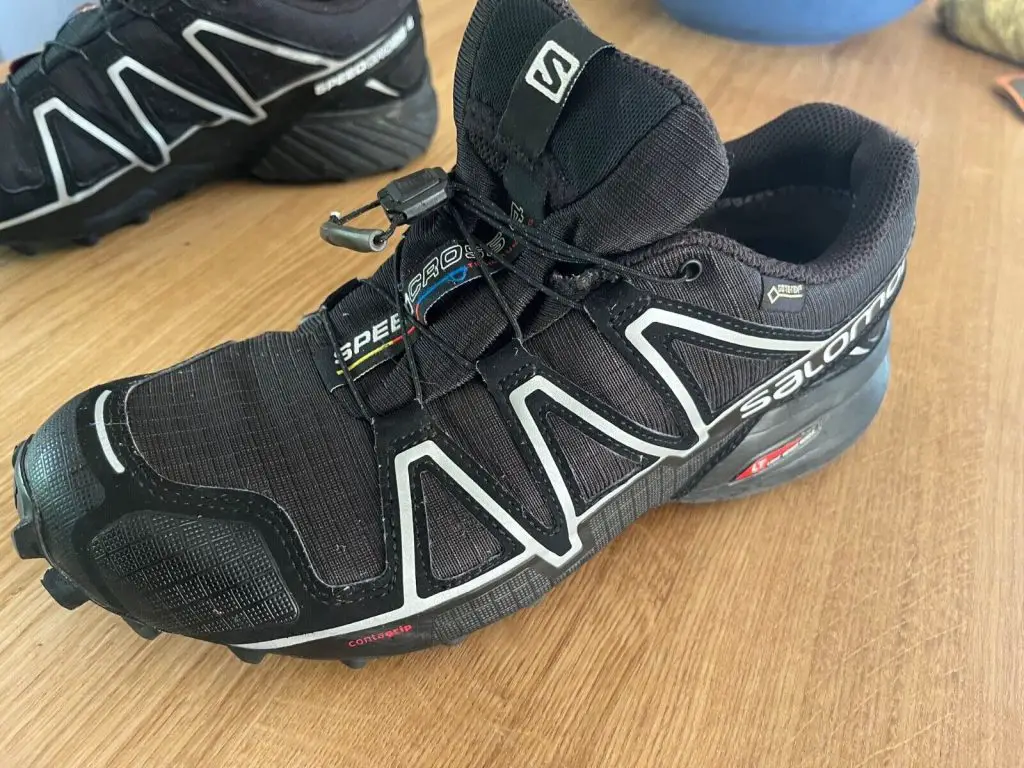Trail running shoes are designed to be lightweight and comfortable, making them a popular choice for runners.
But are trail running shoes any good for hiking? If you’re not 100% in love with running, you might want to use the shoes for other purposes.
While some people swear by them, others are sceptical about their suitability for hiking. I’ve used my trail running shoes for hiking for years.
In this article, we will explore the benefits and drawbacks of using trail running shoes for hiking and provide you with all the information you need to make an informed decision.
Understanding the differences between trail running shoes and hiking shoes is essential to determine if trail running shoes are suitable for hiking. Trail running shoes are designed to be lightweight and flexible, with a focus on speed and agility.
On the other hand, hiking shoes are heavier and sturdier, with a focus on support and durability. While both shoes are designed for outdoor activities, they have different features and are suitable for different terrains and activities.
When it comes to trail running shoes and hiking shoes, there is no one-size-fits-all solution. The choice between these two types of shoes depends on several factors, including terrain, weather conditions, and personal preferences.
In the following sections, we will explore the key factors to consider when choosing between trail running shoes and hiking shoes and provide you with a comprehensive guide to help you make an informed decision.
Key Takeaways
- Trail running shoes are designed for speed and agility, while hiking shoes are designed for support and durability.
- The choice between trail running shoes and hiking shoes depends on several factors, including terrain, weather conditions, and personal preferences.
- When choosing between trail running shoes and hiking shoes, it is essential to consider the terrain, weather conditions, and your personal preferences.
Understanding Trail Running Shoes
Trail running shoes, also known as trail runners, are lightweight, flexible, and have loads of cushion to absorb shock. They are designed for running on forest or mountain trails and not intended for pavement use.

Comfort
Trail running shoes are designed to comfort the wearer, especially during long runs. They are made with breathable materials, which helps to keep the feet cool and dry.
Ensuring your shoes aren’t too big is key for comfort, the shoes are also designed with a wider toe box to allow for natural movement of the toes, which can help to prevent blisters and other foot injuries.
Weight
Trail running shoes are generally lighter than hiking boots, making them more comfortable for long runs. The weight of the shoes can vary depending on the materials used in their construction and the level of support they provide.
Traction
Traction is an essential feature of trail running shoes, as it helps to prevent slips and falls on uneven terrain. The shoes are designed with lugs on the outsole that provide grip on various surfaces, including rocks, roots, and mud.
Support
Trail running shoes provide less support than hiking boots, but they still offer some degree of support to the feet and ankles. The shoes are designed with midsoles that provide cushioning and help absorb shock, reducing the risk of foot injuries.
Protection
Trail running shoes are designed to protect the feet from rocks, roots, and other hazards on the trail. The shoes are made with durable materials that can withstand the wear and tear of running on rough terrain.
Durability
Trail running shoes are designed to be durable, but they may not last as long as hiking boots. The shoes are made of lightweight materials that can wear out more quickly than the heavy-duty materials used in hiking boots. Also, be aware of how any running shoe lasts, even when not using them.
Materials
Trail running shoes are made with various materials, including mesh, uppers, midsoles, and outsoles. The mesh provides breathability, while the uppers are made with durable materials that can withstand the wear and tear of running on rough terrain. The midsoles are designed to provide cushioning and shock absorption, while the outsoles are made with lugs that provide traction on various surfaces.
Overall, trail running shoes are a great option for hiking, especially if you prefer a lightweight and flexible shoe. However, hiking boots may be a better choice if you are planning a long hike or need more support and protection.
Comparison Between Trail Running Shoes and Hiking Shoes
When it comes to hiking, choosing the right footwear is crucial. Two popular options are trail running shoes and hiking shoes. Here’s a comparison of the two:
Comfort and Fit
Trail running shoes are designed to be lightweight and breathable, making them comfortable for long-distance running. They are also available in various sizes and styles to fit different foot shapes.
On the other hand, hiking shoes are designed to provide support and stability for the foot and ankle. They often have a stiffer sole and more ankle support than trail running shoes.
Stability and Traction
Trail running shoes have a lower heel-to-toe drop and a thinner sole, which allows for better ground feel and agility on the trail. They also have smaller lugs on the sole for better traction on dirt and rocky terrain. On the other hand, Hiking shoes have a thicker and more stable sole with larger lugs for better traction on uneven terrain.
Cushioning
Trail running shoes have less cushioning than hiking shoes, which can be a disadvantage on long hikes. Hiking shoes have more cushioning, making them more comfortable for extended periods of walking.
Waterproofing
Hiking shoes are often made with waterproof materials such as Gore-Tex to keep feet dry in wet conditions. Trail running shoes are not typically waterproof, but some models may have a water-resistant coating.
Versatility
Hiking shoes are versatile and can be used for various outdoor activities, including hiking, backpacking, and camping. Trail running shoes, however, are designed specifically for running on trails and may not be suitable for other activities.
In conclusion, trail running and hiking shoes have advantages and disadvantages. Trail running shoes are lightweight and provide better agility on the trail, while hiking shoes offer more support and stability. Ultimately, the choice between the two depends on personal preference and the type of hiking or outdoor activity you plan.
Terrain Suitability and Performance
When it comes to hiking, the terrain you will encounter plays a crucial role in determining the type of footwear most suitable. Trail running shoes are designed to provide traction and stability on various surfaces, making them a good option for hiking on moderate terrain, including dirt paths, grassy fields, and well-maintained trails.
However, if hiking on technical terrain with steep inclines, loose rocks, and uneven surfaces, you may need a sturdier pair of hiking boots to provide additional support and protection. Hiking boots typically have thicker and more robust soles that can handle rugged terrain and provide better grip on slippery surfaces.
If hiking on rocky terrain, hiking boots are the better option as they provide better protection against sharp rocks and uneven surfaces. Trail running shoes may not provide enough support or protection for your feet, which can lead to injuries.
Trail running shoes may be a better option for muddy terrain as they are designed to provide traction on slippery surfaces. They also tend to be lighter than hiking boots, which can be advantageous when hiking in muddy conditions.
On gravel or other uneven surfaces, trail running shoes can perform well, but it is important to choose a pair with a sturdy sole to provide support and prevent injuries. Hiking boots may still be a better option for rugged terrain, but trail running shoes can provide adequate performance on less technical trails.
Trail running shoes can be a good option for hiking on moderate terrain, including dirt paths, grassy fields, and well-maintained trails.
However, if you are hiking on technical terrain, rocky terrain, or rugged terrain, then hiking boots may be a better option to provide additional support and protection to your feet.
Key Factors to Consider
When deciding whether to wear trail running shoes for hiking, there are several key factors to consider. These include speed, durability, ankle support, foot protection, breathability, and mid-foot discomfort.
Speed
If you plan on moving quickly on the trail, trail running shoes may be a good option. They are designed to be lightweight and responsive, which can help you maintain a brisk pace. However, hiking boots may be better if you carry a heavy load or move slowly.
Durability
If you hike frequently or on rugged terrain, you’ll want a durable shoe to withstand wear and tear. Hiking boots are typically made with more durable materials and sturdier construction, making them a better choice for those needing a lasting shoe.
Ankle Support
If you have weak ankles or are prone to ankle injuries, hiking boots may be a better choice. They provide more support and protection for your ankles, which can help prevent injuries on the trail. Trail running shoes typically have less ankle support, making them a riskier choice for those with ankle issues.
Foot Protection
When hiking, it’s important to have a shoe that provides adequate foot protection. Hiking boots typically have a wider toe box and thicker sole, which can help protect your feet from rocks and other hazards on the trail. Trail running shoes may have less foot protection, making them a riskier choice for some hikers.
Breathability
You’ll want a breathable shoe if you hike in hot weather or sweat heavily. Trail running shoes are typically more breathable than hiking boots, which can help keep your feet cool and dry on the trail.
Mid-foot Discomfort
Some hikers may experience mid-foot discomfort when wearing trail running shoes for hiking. This can be due to the lack of support and protection in the mid-foot area. If you experience mid-foot discomfort, hiking boots may be a better choice for you.
Overall, whether trail running shoes are good for hiking depends on your individual needs and preferences. Consider the factors above when making your decision, and choose a shoe that provides the support, protection, and comfort you need on the trail.
Trail Running Shoes and Seasonal Conditions
When it comes to hiking, the season and weather conditions can significantly impact your choice of footwear. Trail running shoes can be a great option for hiking, but it’s essential to consider the conditions you’ll be facing.
Wet and Rainy Conditions
If you plan on hiking in wet or rainy conditions, it’s crucial to opt for trail running shoes that are water-resistant or waterproof. Water-resistant shoes will repel water to some extent, but they won’t keep your feet dry in heavy rain or wet conditions. On the other hand, waterproof versions will prevent water from entering the shoe, keeping your feet dry and comfortable.
Summer Hiking
During the summer months, the weather is generally dry and warm. In such conditions, trail running shoes can be an excellent option for hiking. They are lightweight, breathable, and provide good traction on dry trails. However, it’s important to choose shoes that offer adequate support and cushioning, especially if you plan on backpacking or hiking on rough terrain.
Backpacking
If you plan on backpacking, choosing shoes that provide ample support and cushioning is crucial. Trail running shoes can work well for backpacking, but you must ensure they offer enough support for your feet and ankles. Opt for shoes with a sturdy sole, a snug fit, and good ankle support.
In conclusion, trail running shoes can be an excellent option for hiking, but it’s crucial to consider the conditions you’ll be facing. Choose shoes that offer adequate support, cushioning, and traction based on the season and weather conditions.
Popular Brands and Models
Regarding trail running shoes that are also suitable for hiking, several popular brands and models exist. Here are some of the top picks:
Salomon S/Lab Ultra 3
The Salomon S/Lab Ultra 3 is a highly regarded trail running shoe suitable for hiking. This shoe is designed for long-distance running and features lightweight construction, a comfortable fit, and excellent traction. The shoe is also durable, making it a great choice for hiking on rugged terrain.
La Sportiva Bushido II
The La Sportiva Bushido II is another popular option for those looking for a trail running shoe that can double as a hiking shoe. This shoe is designed for technical terrain and features a sticky rubber outsole that provides excellent traction. The shoe is also breathable and lightweight, making it a great choice for warm weather hiking.
Hoka One One Speedgoat 4
The Hoka One One Speedgoat 4 is a versatile trail running shoe that is also suitable for hiking. This shoe features a cushioned midsole that provides excellent comfort and support and a durable outsole that offers good traction on various surfaces. The shoe is also lightweight, making it a great choice for long hikes.
Altra Lone Peak 4.5
The Altra Lone Peak 4.5 is a popular trail running shoe suitable for hiking. This shoe features a wide toe box that allows your toes to splay naturally and a cushioned midsole that provides excellent comfort and support. The shoe is also durable and features a grippy outsole that provides good traction on various surfaces.
Saucony Peregrine 11
The Saucony Peregrine 11 is a versatile trail running shoe suitable for hiking. This shoe features a cushioned midsole that provides excellent comfort and support and a durable outsole that offers good traction on various surfaces. The shoe is also lightweight, making it a great choice for long hikes.
Overall, many excellent trail running shoes can also be used for hiking. When choosing a shoe, it’s important to consider comfort, support, durability, and traction factors. By doing so, you can find a shoe that will help you easily tackle even the toughest trails.
Conclusion
In conclusion, trail running shoes can be a great option for hiking, but it depends on the specific hike and personal preferences.
For those looking for a lightweight and very comfortable option, trail running shoes are a great choice. They are also a favourite pair for many backpackers and thru-hikers due to their versatility and durability. However, it’s important to note that they may not be the best option for off-trail or rugged terrain, as they may not provide enough support or protection.
On the other hand, hiking shoes or boots are specifically designed for hiking and provide more support and protection for the feet and ankles. They are the best option for those planning to hike on rugged terrain or carrying heavy backpacks.
Ultimately, the decision between trail running shoes and hiking shoes or boots comes down to personal preference and the specific requirements of the hike. Choosing the best option for your needs is important to ensure a safe and enjoyable hiking experience.
Frequently Asked Questions
Can trail running shoes be used for hiking?
Yes, trail running shoes can be used for hiking. However, it’s important to note that trail running shoes have different features than hiking shoes, which may affect your performance and comfort level.
What are the differences between trail running shoes and hiking shoes?
Trail running shoes are designed for running on trails. They are typically lighter and more flexible than hiking shoes. On the other hand, hiking shoes are designed to provide more support and protection for your feet and ankles on rugged terrain. They are often heavier and have stiffer soles than trail running shoes.
Are trail running shoes suitable for trekking?
Trail running shoes can be suitable for trekking, depending on the trekking you plan to do. If you’re planning a long-distance trek with a heavy backpack, you may want to consider using hiking shoes instead of trail running shoes. Hiking shoes provide more support and protection for your feet and ankles, which can help prevent injuries on the trail.
Can you use trail running shoes for backpacking?
Trail running shoes can be used for backpacking, but it’s important to consider the weight of your backpack and the terrain you’ll be hiking on. If you’re carrying a heavy backpack and hiking on rugged terrain, you may consider using hiking shoes instead of trail running shoes.
What are the pros and cons of using trail running shoes for hiking?
The pros of using trail running shoes for hiking include their lightweight design, flexibility, and breathability. They can also be more affordable than hiking shoes. The cons of using trail running shoes for hiking include their lack of support and protection for your feet and ankles, which can increase your risk of injury on the trail.
What should I consider when choosing between hiking shoes and trail running shoes?
When choosing between hiking shoes and trail running shoes, consider the type of hiking or trekking you plan to do, the terrain you’ll be hiking on, the weight of your backpack, and your personal comfort level. If you’re planning a long-distance trek with a heavy backpack, hiking shoes may be a better choice. If you’re planning a shorter hike on a well-maintained trail, trail running shoes may be a good option.

